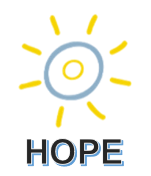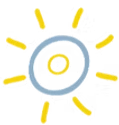MOOC VOOR INFORMELE ZORGVERLENERS-FINAL-NL
Schema della sezione
-
ERASMUS+ HOPE
KA220-HED-F8D51393, Hoger Onderwijs
Reageren op hittegolven in de leefomgeving van ouderen

HOPE: MOOC voor mantelzorgers
Deze online cursus is speciaal ontwikkeld voor mensen die graag leren door korte teksten te lezen, videoclips te bekijken en vragen te beantwoorden. Deze cursus is bedoeld voor mensen die in tijden van hittegolven voor ouderen zorgen: formeel en informeel. Maar ook voor iedereen die wil weten wat er gedaan kan worden in tijden van zeer hoge temperaturen, hoe je koel kunt blijven en hoe je hittestress kunt voorkomen. In deze cursus delen wij deze kennis op een snelle en toegankelijke manier.
Deze tool is gratis en wanneer u deze hebt afgerond, kunt u een certificaat downloaden, dat ook gratis is. Het doorlopen van deze cursus en het beantwoorden van alle vragen kost ongeveer 30 minuten van uw tijd. Als u een vraag verkeerd hebt beantwoord, ziet u direct feedback met een uitleg.
Wilt u meer diepgaande informatie over hittegolven, de oorzaken en gevolgen ervan? Er is een gratis Engelstalige e-learning beschikbaar die met EU-steun is ontwikkeld en speciaal is bedoeld voor professionals in de gezondheidszorg en welzijn. Klik op onderstaande link om de e-learning voor professionals te starten.
https://e-learning.hopeheatwaves.eu/course/view.php?id=4
Om met deze MOOC te beginnen, scroll naar beneden naar DEEL 1

- PARTNERS
- GEMEENTE ROTTERDAM Netherlands, www.rotterdam.nl
- INSTITUUT VOOR ZIEKENHUIS- EN ZORGDIENSTEN VOOR OUDEREN, Italië, https://www.israa.it
- BROEDERSCHAP VAN HET HEILIGE HUIS VAN MISERICORDIA DA AMADORA, Portugal, https://www.misericordia-amadora.pt/
- STICHTING HOGESCHOOL ROTTERDAM, Netherlands, https://www.hogeschoolrotterdam.nl
- Sociaal coöperatief bedrijf van de Cycladen, GRIEKENLAND, https://e-learning.alteravita.eu/
- ELISAN EUROPEES NETWERK VOOR INCLUSIE EN LOKALE SOCIALE ACTIEVERENIGING
, Frankrijk, https://elisannetwork.wixsite.com/elisan-network

HOPE WEBPAGINA: https://hopeheatwaves.wixsite.com/hope
VRIJWARING
De steun van de Europese Commissie voor de productie van deze publicatie houdt geen goedkeuring in van de inhoud ervan. De inhoud ervan geeft uitsluitend de mening van de auteurs weer. De Commissie kan niet aansprakelijk worden gesteld voor het gebruik dat van de hierin opgenomen informatie kan worden gemaakt.

-
Samenvatting
In verschillende landen lijken de gezondheidsgevolgen van hitte, ondanks het toenemende aantal extreme temperatuurepisodes, af te nemen. Dit benadrukt de effectiviteit van de huidige preventiemaatregelen. Toch wijzen prognoses voor Europa er duidelijk op dat, zonder voldoende inspanningen om aanpassing aan hitte en gezondheid in het licht van klimaatverandering te bevorderen, de blootstelling aan hitte en de daarmee samenhangende gezondheidsgevolgen aanzienlijk kunnen toenemen. Dergelijke prognoses, in combinatie met de langetermijntrends van vergrijzing en verstedelijking, onderstrepen sterk de noodzaak om een langetermijnperspectief te hanteren bij het beheersen van de gezondheidseffecten van temperatuur in de context van een veranderend klimaat.
Klik op de onderstaande video om te beginnen.Het klimaat van Europa in 2050
-
Samenvatting deel 2
In dit deel van de MOOC worden verschillende methoden geïntroduceerd om u, uw familie en uw patiënten te helpen koel te blijven tijdens extreem warme dagen. Zoals u in het eerste deel hebt gezien, mag de impact van hitte op de gezondheid niet worden onderschat, aangezien langdurige blootstelling aan hoge temperaturen kan leiden tot hitte-uitputting, uitdroging en ernstigere aandoeningen zoals een hitteberoerte. Begrijpen hoe u de lichaamstemperatuur kunt beheren en een koelere omgeving kunt creëren, is cruciaal, vooral voor kwetsbare groepen zoals ouderen, jonge kinderen en personen met reeds bestaande gezondheidsproblemen.
In het eerste deel van dit hoofdstuk leert u over praktische technieken om uw lichaam af te koelen en een comfortabele kerntemperatuur te behouden. Deze methoden omvatten hydratatiestrategieën, geschikte kledingkeuzes en tips voor fysieke activiteit tijdens hittegolven. Door deze technieken toe te passen, kunt u hittegerelateerde ziekten helpen voorkomen en uw algehele comfort tijdens warm weer verbeteren.
In het tweede hoofdstuk van de MOOC onderzoeken we hoe u uw leefomgeving koel en leefbaar kunt houden tijdens extreme hitte. Dit omvat tips over hoe u uw huis efficiënt kunt ventileren, het gebruik van ventilatoren of airconditioning en manieren om warmte te blokkeren met gordijnen of reflecterende materialen. Daarnaast wordt advies gegeven over het creëren van koelere ruimtes in uw huis en welke acties u kunt ondernemen als er geen airconditioning beschikbaar is.
Het is belangrijk om te erkennen dat ieders situatie anders is. Wat het beste werkt voor de ene persoon, is mogelijk niet zo effectief voor de ander. Daarom is het essentieel om uw eigen behoeften en omstandigheden te beoordelen en erachter te komen welke strategieën het meest geschikt zijn voor u, uw familie en uw patiënten. Deze MOOC begeleidt u door een reeks opties, maar de uiteindelijke verantwoordelijkheid ligt bij u om deze suggesties af te stemmen op uw specifieke situatie. Geïnformeerd en voorbereid zijn kan een aanzienlijk verschil maken in uw vermogen om met extreme hitte om te gaan.
-
Samenvatting
Nadat u heeft geleerd over de gevaren van extreme hitte voor de gezondheid, met name voor kwetsbare personen, en manieren hebt ontdekt om uzelf, uw gezin en uw huis koel te houden, breidt dit hoofdstuk de focus uit naar uw bredere gemeenschap en stad. Het onderzoekt de aanzienlijke impact van hitte op stedelijke gebieden, waar de effecten nog intenser kunnen zijn. U krijgt inzicht in het stedelijke hitte-eilandeffect en hoe stedelijke gebieden meer warmte vasthouden. Dit hoofdstuk benadrukt de acties die u kunt ondernemen om de hitte in uw buurt te verminderen, van het aanmoedigen van het creëren van groene ruimtes tot het pleiten voor het gebruik van koele daken en reflecterende materialen .
Bovendien benadrukt dit gedeelte de rol van betrokkenheid van de gemeenschap en de lokale overheid bij het bestrijden van de risico's van extreme hitte. U leert over strategieën zoals het planten van bomen, het verbeteren van stadsplanning en het vergroten van het bewustzijn van het publiek over het belang van het verminderen van blootstelling aan hitte. Het nemen van deze stappen helpt niet alleen om uw buurt af te koelen, maar verbetert ook de algehele kwaliteit van leven en veerkracht van uw stad tijdens hittegolven. Of het nu gaat om kleine veranderingen in uw huis of collectieve inspanningen in uw lokale omgeving, u hebt de macht om een aanzienlijk verschil te maken in het verzachten van de effecten van extreme hitte in uw gemeenschap.
-
-
Op deze pagina vindt u alle EEA-content die uitsluitend over Nederland gaat. Andere producten die informatie over onder andere Nederland bevatten, kunt u vinden via onze geavanceerde zoekfunctie .
https://www.eea.europa.eu/en/countries/eea-member-countries/netherlands
-
-
Bedankt voor uw bezoek aan onze HOPE-database met goede praktijken. Uw feedback is waardevol om ons te helpen de impact van ons product te monitoren en het in de toekomst te verbeteren. Neem een paar minuten de tijd om dit formulier in te vullen. Uw antwoorden blijven vertrouwelijk.
Hoop Team
-




